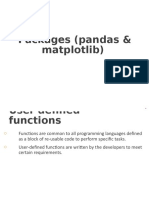0 ratings0% found this document useful (0 votes)
11 viewsData Analytics Using Python
The document outlines a step-by-step guide for performing exploratory data analysis on a car dataset using Python libraries, specifically Pandas and Matplotlib. Key tasks include loading the dataset, displaying its contents, generating summary statistics, and visualizing data through various plots. Additionally, it covers data cleaning techniques such as dropping irrelevant columns, handling duplicates, and removing missing values.
Uploaded by
ykashish456Copyright
© © All Rights Reserved
Available Formats
Download as DOCX, PDF, TXT or read online on Scribd
0 ratings0% found this document useful (0 votes)
11 viewsData Analytics Using Python
The document outlines a step-by-step guide for performing exploratory data analysis on a car dataset using Python libraries, specifically Pandas and Matplotlib. Key tasks include loading the dataset, displaying its contents, generating summary statistics, and visualizing data through various plots. Additionally, it covers data cleaning techniques such as dropping irrelevant columns, handling duplicates, and removing missing values.
Uploaded by
ykashish456Copyright
© © All Rights Reserved
Available Formats
Download as DOCX, PDF, TXT or read online on Scribd
You are on page 1/ 7
Data Analytics Using Python Libraries, Pandas
and Matplotlib
We’ll use a car.csv dataset and
perform exploratory data analysis using Pandas
and Matplotlib library functions to manipulate and
visualize the data and find insights.
1. Import the libraries
2. . Load the dataset using
pandas read_csv() function.
3. Display the head of the dataset using
the head() function.
4. Display the bottom 5 rows from the dataset
using the tail() function.
5. Print summary statistics of the dataset using
the describe() function.
6.Plot a histogram for all the variables.
7. Box plot to visualize the relationship between
vehicle size and engine hp.
8. Build a pair plot using the seaborn library
9. Drop irrelevant columns from the dataset
using drop() function.
10. Use rename() function to rename the columns.
11. Print the total number of duplicate rows.
12. Remove the duplicate rows using
the drop_duplicates() function.
13. Drop the missing values from the dataset.
14. Plot a histogram to find the number of cars per
brand.
15. Draw a correlation plot between the variables.
You might also like
- Python Dataframe Assignment No 1 - AnswerkeyNo ratings yetPython Dataframe Assignment No 1 - Answerkey7 pages
- Exploratory Data Analysis (EDA) Using PythonNo ratings yetExploratory Data Analysis (EDA) Using Python21 pages
- Data Frames and Charts 2: 2.1 Dealing With Missing ValuesNo ratings yetData Frames and Charts 2: 2.1 Dealing With Missing Values12 pages
- Assignment - CarsData - Descriptive - EDA - Munjal - Exercise - Ipynb - ColaboratoryNo ratings yetAssignment - CarsData - Descriptive - EDA - Munjal - Exercise - Ipynb - Colaboratory6 pages
- Practical 2 .Ipynb - Colab (1) - Copy (1)No ratings yetPractical 2 .Ipynb - Colab (1) - Copy (1)9 pages
- 1.5 Data Analysis with Python- Exploratory Data Analysis 1No ratings yet1.5 Data Analysis with Python- Exploratory Data Analysis 117 pages
- Pandas Complete + Visualisation Summary of IBM VisualizationNo ratings yetPandas Complete + Visualisation Summary of IBM Visualization21 pages
- Summary: Introduction To Data Visualization ToolsNo ratings yetSummary: Introduction To Data Visualization Tools13 pages
- An Extensive Step by Step Guide To Exploratory Data AnalysisNo ratings yetAn Extensive Step by Step Guide To Exploratory Data Analysis26 pages
- ICT550 Car - Detail - MUHAMMAD FAZLIEE AIMAN 2021122331No ratings yetICT550 Car - Detail - MUHAMMAD FAZLIEE AIMAN 20211223319 pages
- Report On Petroleum Consumption Data Analytics: - Submitted byNo ratings yetReport On Petroleum Consumption Data Analytics: - Submitted by18 pages
- Automobil E Data Analysis: Name Pgp-Dsba Online January' 21 Date: Dd/mm/yyyyNo ratings yetAutomobil E Data Analysis: Name Pgp-Dsba Online January' 21 Date: Dd/mm/yyyy11 pages
- Machine Learning in the AWS Cloud: Add Intelligence to Applications with Amazon SageMaker and Amazon RekognitionFrom EverandMachine Learning in the AWS Cloud: Add Intelligence to Applications with Amazon SageMaker and Amazon RekognitionNo ratings yet
- Data Analytics Using the Python Library (1)No ratings yetData Analytics Using the Python Library (1)7 pages
































































